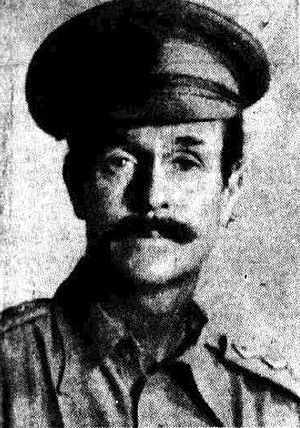Ian Fairweather facts for kids
Quick facts for kids
Ian Fairweather
|
|
|---|---|

Australian painter Ian Fairweather during WWII
|
|
| Born | 29 September 1891 Bridge of Allan, Stirlingshire, Scotland
|
| Died | 20 May 1974 (aged 82) Brisbane, Queensland, Australia
|
| Known for | Painting |
Ian Fairweather (born September 29, 1891 – died May 20, 1974) was a Scottish painter. He lived in Australia for most of his life. His art mixed ideas from both Western and Asian cultures.
Contents
Life of Ian Fairweather
Ian Fairweather was born in 1891 in Bridge of Allan, Scotland. When he was a baby, his parents went back to India. He stayed with his great-aunt and did not see his parents again until he was 10. He went to school in Jersey, London, and Switzerland. Later, he trained to be an army officer in Belfast.
World War I and Art Studies
During World War I, Ian Fairweather was captured by German soldiers in France. He spent four years in prisoner-of-war camps. While he was a prisoner, he was allowed to study drawing and Japanese. He drew pictures for many magazines made by the prisoners. He tried to escape many times, which led to him spending long periods alone.
After the war, he studied art in the Netherlands, London, and Munich. In 1918, he went to the Royal Academy of Art in The Hague. He also studied Japanese at the School of Oriental Studies. From 1920 to 1924, he attended the famous Slade School of Fine Art in London.
Travels and Painting
After his studies, Fairweather began to travel a lot. He visited places like Canada, Shanghai, Bali, Colombo, and Australia. Everywhere he went, he painted. He would send his paintings to art galleries, but at first, he did not sell many.
In 1934, he joined other artists in Melbourne, Australia. He even started painting a large picture for a hotel there. Later that year, he left Australia and continued his travels. He went to many cities, including Shanghai, Peking, Manila, Singapore, and Calcutta.
Serving in World War II
From 1941 to 1943, he served as a captain in the British Army in India during World War II. After leaving the army in 1943, he traveled back to Australia. He visited Melbourne, Cairns, Cooktown, and Brisbane. He eventually settled into an art studio in Melbourne.
By this time, his paintings were becoming well-known. Important art galleries in London, like the Tate, had bought his works.
Life on Bribie Island
In 1951, Fairweather moved to Darwin. He lived in old trucks and boats. He was likely feeling very sad during this time. He built a raft and sailed out into the open sea by himself. People in Australia thought he had died because searches did not find him. However, he survived and landed on Rote Island in Indonesia.
Indonesian officials found him and put him in prison. He was later sent back to London. In 1953, at age 62, he returned to Brisbane. He built a small hut on Bribie Island in Queensland. He lived there for the rest of his life, only leaving for short visits to India and London in the 1960s.
Ian Fairweather's Artworks
Ian Fairweather's paintings are very special. They combine ideas from European art with the beautiful writing styles of China.
Famous Paintings
One of his paintings, Monastery, was bought by the National Gallery of Australia. Art experts called it a masterpiece. Another artist, James Gleeson, said that Fairweather created a "fascinating mix" of European art and Chinese writing.
Fairweather was one of the few European painters who used ideas from Oceanian art (art from islands in the Pacific Ocean). His style has been called "sophisticated clumsiness," meaning it looked simple but was actually very clever.
Materials and Exhibitions
He often used cheap materials like cardboard or newspaper and low-quality paints. Because he lived in a tropical climate, many of his artworks were lost or damaged by the weather.
Fairweather's art was shown in a big exhibition called "Australian Painting Today" at the Tate Gallery in London. In the same year, his work was chosen to represent Australia at the São Paulo Art Biennial, a major art show in Brazil.
His paintings are now in all the main art galleries in Australia. They are also in the Tate Gallery in London, the City Gallery in Leicester, and the Ulster Museum in Belfast. It is interesting that the only exhibition of his own works he ever saw was a show in 1964 at the Queensland Art Gallery.
The Drunken Buddha
In 1965, Fairweather published a book called "The Drunken Buddha." He had translated it from Chinese and added twelve of his own paintings. The book is a story about a wise Chinese teacher named Tao Chi. His unusual way of teaching was part of an old Chinese tradition.
In April 2019, one of Fairweather's paintings, "Barbecue," sold for $1.7 million.
See also
- Australian art

